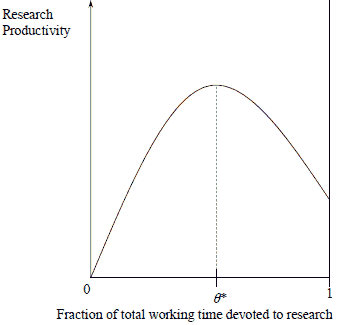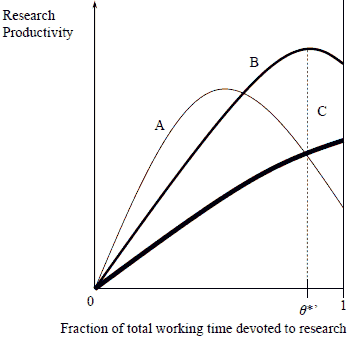Gonzalo Forgues-Puccio
University of St Andrews Published September 2009
Once during a job interview I got one of the questions that you are supposed to answer, “no, of course not”, but then you find yourself in a position in which is very difficult to elaborate without sounding suspiciously deceptive. The question was: “Do you consider that teaching is a hindrance for research?”
Certainly it is a tricky question, and probably you understand what I meant by saying that this is the kind of query to which you immediately must respond with a clear and definite “no”. The problem is that not everybody believes in this automatic answer. To some young academics teaching is just something that comes with the job, and that has to be done in order to explore the fascinating topics that motivated them to undertake doctoral studies.
In this short essay, I want to propose a simple theory to explain how teaching may increase research productivity. I focus exclusively on new lecturers because we are prone to make judgement errors, which of course can be rectified with experience. The analysis is based on my own experience and on casual observations. I do not have any formal evidence to support my claims. Nonetheless, I think that my discussion may be useful to some people on the early days of their careers.
Academics are a rare breed. We are in the habit of working harder than the rest from early years. We are accustomed to success and awards. The great majority of us were top students. We also persevere to the point of stubbornness. This is a salient feature especially in young academics. Hence, we have the tendency to keep working in a research project even though our productivity is decreasing. If you found yourself trying to complete a paper and not being able to write a decent paragraph you know what I am talking about.
Economic theory tells us that rational agents value both consumption of goods and having free time. The problem is that agents have a limited amount of time and they need to work in order to generate income. Hence, agents choose optimally the amount of time they devote to work in order to maximise the aggregate satisfaction that they derive from consumption of goods and from leisure.
Once new lecturers decide how much time is devoted to work (and how much to leisure), we have to make a second decision. We have to decide how to allocate our working time between research and teaching. As with a large number of activities in life, there is a serious possibility that the relationship between time devoted to research, and research productivity, may not be monotonic. This implies that assigning the totality of our working time to investigative activities may not necessarily imply optimising research output. At some point fatigue and saturation may start to appear. It is quite likely that there is an optimal fraction of working time that we should devote to research in order to maximise research productivity.
Figure 1

Let us assume that we are working in a single research project and we have to decide how much time is allocated to research. In my experience, the relationship between time dedicated to research and productivity is represented by the inverted U-shaped curve in Figure 1. In the horizontal axis we have the fraction of total working time devoted to research and on the vertical axis we have research productivity. As we allocate an increasing fraction of our working time to research, our productivity increases at a diminishing rate until we reach an optimal value represented by θ*. After this point, if we assign additional time to research our productivity starts to fall.
The problem with new lecturers is that we have difficulties identifying the optimal amount of time we should devote to research. Hence, even though we experience saturation and fatigue, we push ourselves to keep working on our research project. Otherwise, we feel that we are not working hard enough and that we will not complete with success our probationary period. Coming back to Figure 1, this means that new lecturers have a tendency to position themselves to the left of the optimal value θ*.
In this context, an appropriate teaching load would force new lecturers to devote less time to research, allowing them to maximise research productivity. Of course it is also true that an excessive teaching load would undermine research productivity by preventing new lecturers from reaching θ*.
Figure 2

Now probably you are thinking that another way to stop getting tired of your research is having multiple research projects. And yes, you are absolutely right. However, bear in mind that this is not always straightforward for young researchers. Let me illustrate this case in Figure 2. Again we have in the horizontal axis the fraction of total working time devoted to research and on the vertical axis we have research productivity. Notice that now we have three curves. Curve “A” represents the single project case of Figure 1; curve “B” corresponds to the case with multiple research projects; and curve “C” stands for the case with “too many” research projects.
In the case with multiple projects (curve “B”), devoting a small fraction of our time to research implies lower (aggregate) research productivity than with a single project (curve “A”). However, after some point our productivity increases more than with a single project. The reason is that with multiple research projects it is more difficult to keep on top of things if we do not dedicate enough time to them. However, once we start devoting more and more time to research we start having “research spillovers”. Probably you have noticed that when you are working in two projects simultaneously, you can take ideas from one project and apply them to the other. The knowledge you accumulate in a particular piece of work “spills over” the other piece. However, this only happens once you really get into both projects. There is another interesting point illustrated by curve “B”: with multiple projects the optimal fraction of total working time devoted to research is greater than with a single project.
In addition, there is also the risk of getting involved in far too many projects. As I said, this situation is represented in Figure 2 by curve “C”. In this case, given that the amount of time we devote to work is limited, our productivity for most of the values of θ is below the case with a single project (curve “A”), and always below the case with a reasonable number of research projects (curve “B”). As they say, “Jack of all trades, master of none”. In curve “C”, we do not get to experience “research spillovers”. We just spend all our time trying to understand all the different projects we are simultaneously working on!
To conclude, I want to say that I strongly believe that teaching can potentially help new lecturers to maximise research productivity. As I explained, teaching prevents us from harming our efficiency by spending too much time doing research. This is particularly true if new lecturers focus in a single research project. Of course with time, new lecturers stop being new lecturers. We learn, and more importantly, we correct our errors. In the mean time, however, if you get tired about a paper leave it to rest. Enjoy your teaching and everything will be revealed (I hope).

